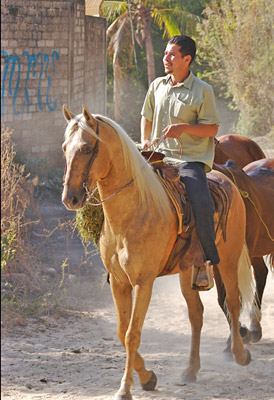
Where do you draw the line when taking pictures of strangers on location? Do you always need permission first? Is a model release necessary for every shot that includes a person? What's the difference between assertive and obnoxious?
During my last trip to Mexico, I had a good conversation with photographer-friend Ben Long that addressed these very topics. We were taking pictures in villages on the outskirts of Puerto Vallarta and found ourselves discussing what's appropriate and what isn't.
For example, the photo of the young man riding a horse was a situation where he knew I was taking photos of him. At one point he even smoothed his hair. I never asked formal permission, but did make eye contact before I took the shots. Since he is recognizable in this composition, I would not use this photo for commercial purposes. I didn't get a model release. But I am comfortable using this picture for teaching and reporting.
The second picture, below, is of a woman washing clothes in a stream. I was on the other side of the water with a steep grade between us. I was not able to interact with her during the shoot. Even though she is not recognizable by my definition, I would not use this shot for commercial purposes either. Technically, I believe I could. But I would be more comfortable with a model release. So, I'll use this image for teaching and leave it at that.

I have no absolute rules on this subject. I've included these images as part of the discussion. Keep them in mind as you listen to Ben and I talk about our adventures in Mexico.
Listen to the Podcast
Now that I've piqued your curiosity, it's time to listen to today's audio show titled, "Street Shooting Etiquette." You can download the podcast here (22 minutes).
Technorati Tags: digital photography, podcast, tips















Street shooting is always a challenge especially for a shy person like myself, but it's been a great exercise in moving past that to create images. Sometime if I see a moment, I shoot it before I getting permission or making eye contact. If they then notice, I will smile and if possible engage them in conversation. If they are curious about what I'm doing, I will often tell them what is was about them or what they were doing that intrigued me and propelled me to take a picture. Other times, when I see someone involved in an activity, I will either start shooting or start speaking to them about their activity. This usually breaks the ice. There is no hard and fast rule that I adhere to.
I think it's important to be upfront about what you're doing. I have found that most people are curious if not flattered that you want to take a picture of them. I think honesty goes a long way and I agree with you that being dishonest isn't right. I know people do it, but personally I'd rather not have to lie to justify a photograph.
Great topic.
Although I agree with what was said in the podcast and with the other comment here, I find that when somone knows they are being photographed they act differently and somtimes un-natural.
Some of the best pictures are of people just living their lives, but again this brings up the issue is it wrong to photograph them, and if you do should you use the shot.